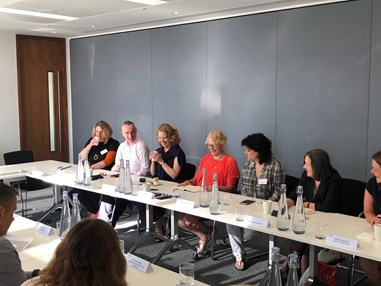Earlier this week, we hosted a roundtable with industry leaders, policymakers and social influencers to debate how to help women achieve equality with men in their savings and investment outcomes. We were very excited to have as our guest speaker Anne Boden (CEO of Starling Bank) who spoke eloquently about her own journey towards setting up Starling, and her campaign #MakeMoneyEqual. The ABI Boardroom has rarely had this many senior women round the table!

Research on gender inequality in savings outcomes makes for uncomfortable reading. On average, women say they have saved £64,000 over their lifetime, significantly less than men’s £125,000. As we know from the mandatory disclosures this year, women are facing a stark gender pay gap and are over-represented among low earners. And they don’t tend to fight for a fair share of their partner’s pension saving on divorce either.
So what is driving these outcomes, and how do we get to a better place? It is a very complex issue with some deep-seated cultural factors.
Blatant linguistic bias in popular culture
The #MakeMoneyEqual campaign highlights how lifestyle magazines for men and women adopt a different tone when writing about money. Women ‘splurge on shoes’, men ‘invest in suits’. Research informing the campaign shows that much money-related content in women’s magazines patronises women, treating them as micro savers, interested primarily in ‘discounts and bargains’, anxiety-riven, and having to provide for the family.
In contrast, money content in men’s magazines is upbeat, but worryingly associates money with peer pressure, goading men to take greater risks, and using flamboyant images (yachts and sports cars) to convey monied status as a masculine ideal. It also gives tips about how to prepare for divorce.
No wonder then that analysis by the Pensions Advisory Service shows that “sorry” is the most prevalent word when women call the service.
The law
We should also not underestimate the long shadow cast by the law. Women have had the right to vote for 100 years, but it was only in 1990 that independent taxation was introduced, assessing married couples as separate persons for income tax and capital gains tax. Before 1990, a wife’s income was added to her husband’s on his tax return(!).
Worse still, until 1950, the definition of incapacitated person for purposes of income tax was “any infant, married woman, lunatic, idiot or insane person.”
So our starting point for culture change is not great. But there is hope.
Asset ownership is key
A key factor is auto-enrolment into workplace pensions. Not only did it double the percentage of women in the private sector with a workplace pension in a matter of four years, it is also a building block to help women take control of their own financial destiny.
Asset ownership is empowering and already beginning to change behaviour: NEST’s excellent report “How the UK Saves” shows that, having controlled for earnings, women tend to be better retirement savers than men in all income cohorts but the highest earners. This is really encouraging given NEST represents nearly 6.5 million members.
Financially fabulous
Things are also looking up in terms of changing the popular narrative and with it, attitudes. Last month, Hearst UK, publisher of Good Housekeeping, Cosmopolitan, House Beautiful and Red, launched a new consumer facing campaign, Financially Fabulous. This initiative will offer regular financial content on-line and in print across Hearst’s UK brands, as well as books, guides and vlogs, all with the ambition to empower women to feel confident about their finances. This has the potential to make a huge difference to how many women feel about money and investments.
Intervention points
Our debate also identified points in women’s lives where financial ‘cheat sheets’ could help women save for and protect their future. In particular, what should they consider financially when taking maternity leave or a caring break, and in the event of divorce. As a prominent consumer campaigner once said, “a man is not a financial plan”!
Not many women are aware that their partner can pay into their pension while they are on maternity leave or are taking a caring break. And only 9% of married people say they want a fair share of their partner’s pension if they get divorced (but 13% are concerned about losing a pet!). The Money Advice Service’s material on the subject is excellent but we need it to reach a much wider audience to help change behaviour.
There is more that the industry can do to help and make sure these issues are better understood, and we at the ABI are considering where we can add most value. It is in the industry’s enlightened self-interest to help the other half of the population to become more confident about money issues, and I look forward to working with the sector, policymakers and opinion formers to create an environment in which women can truly own their futures.
